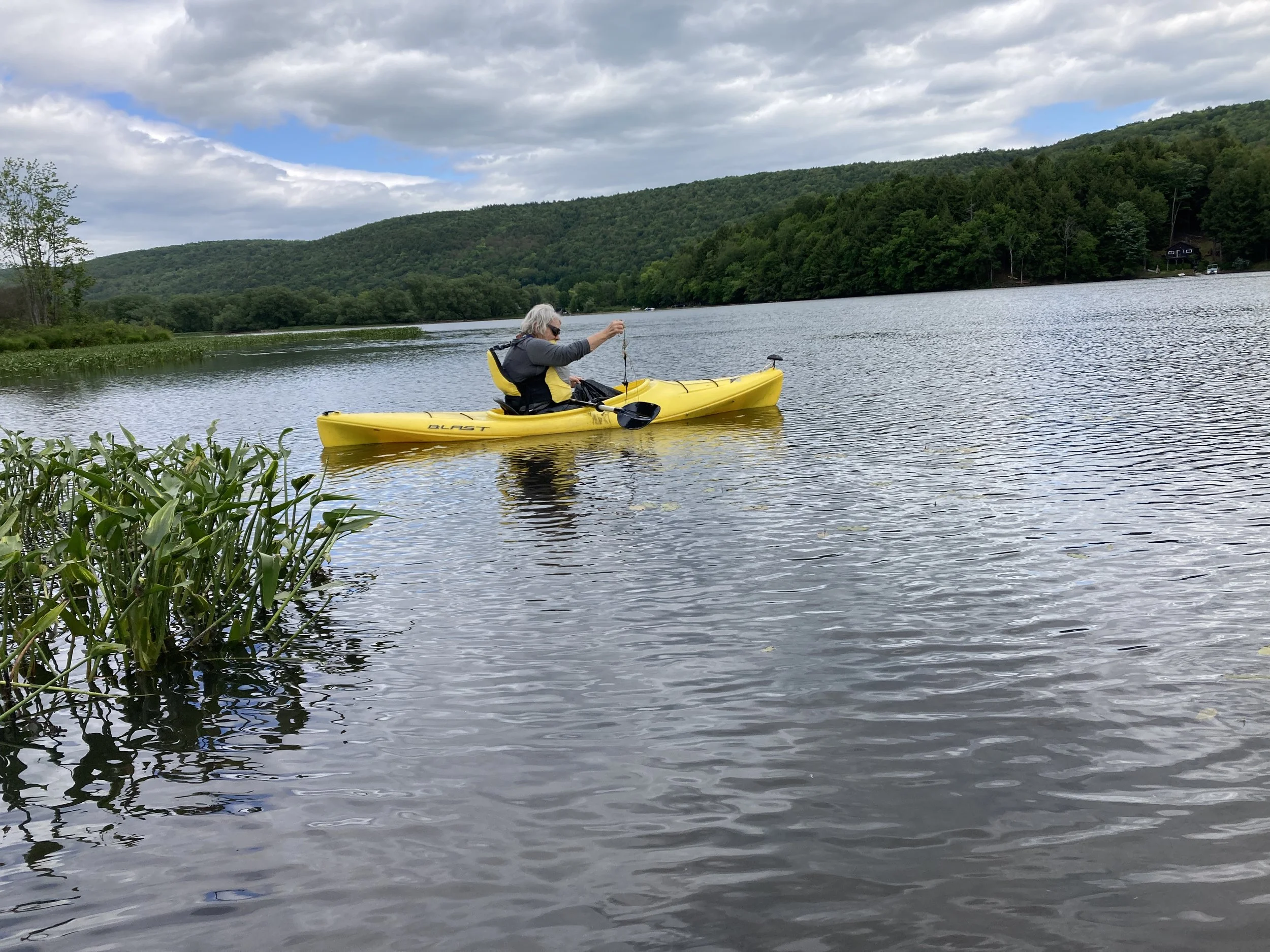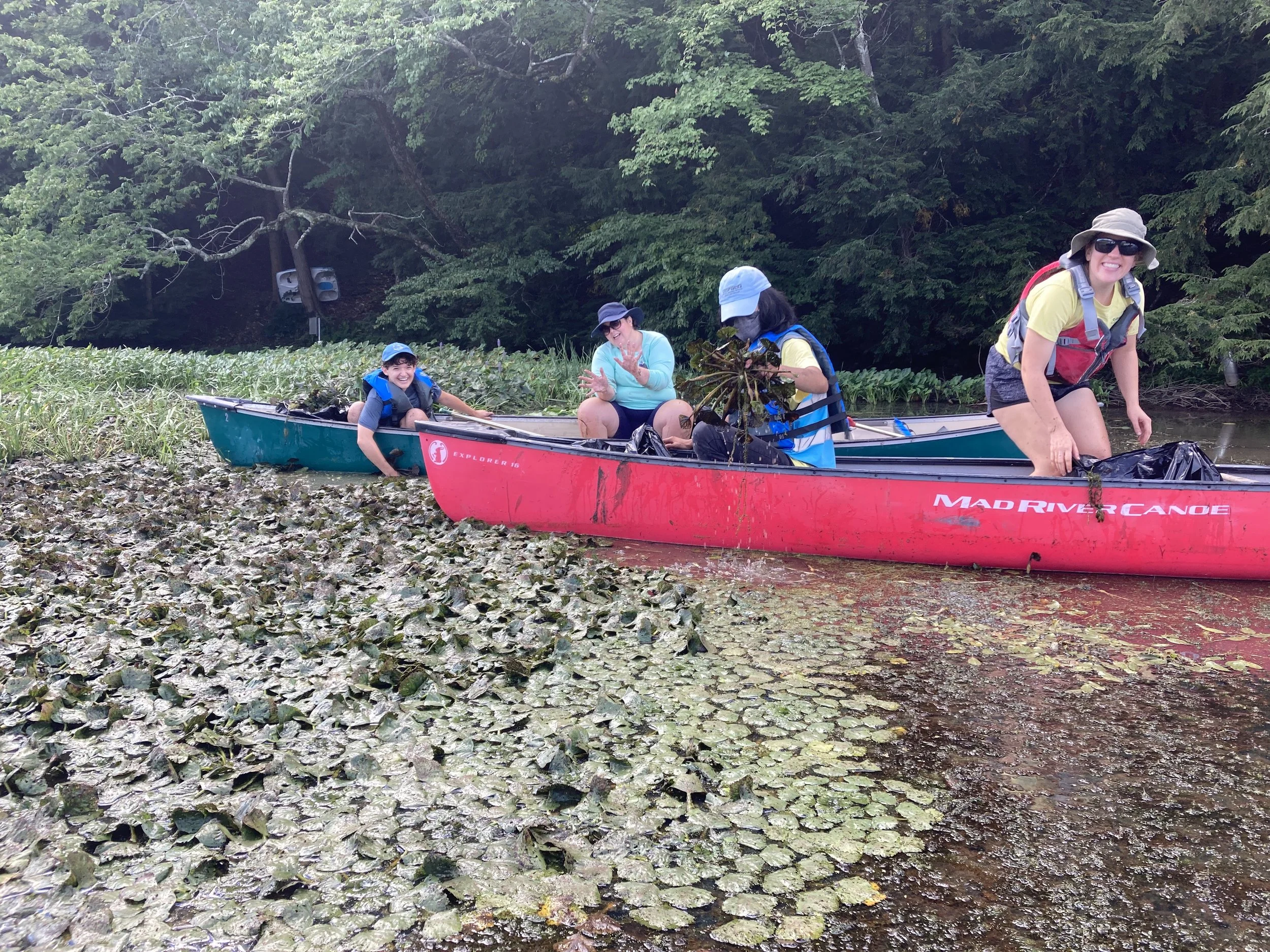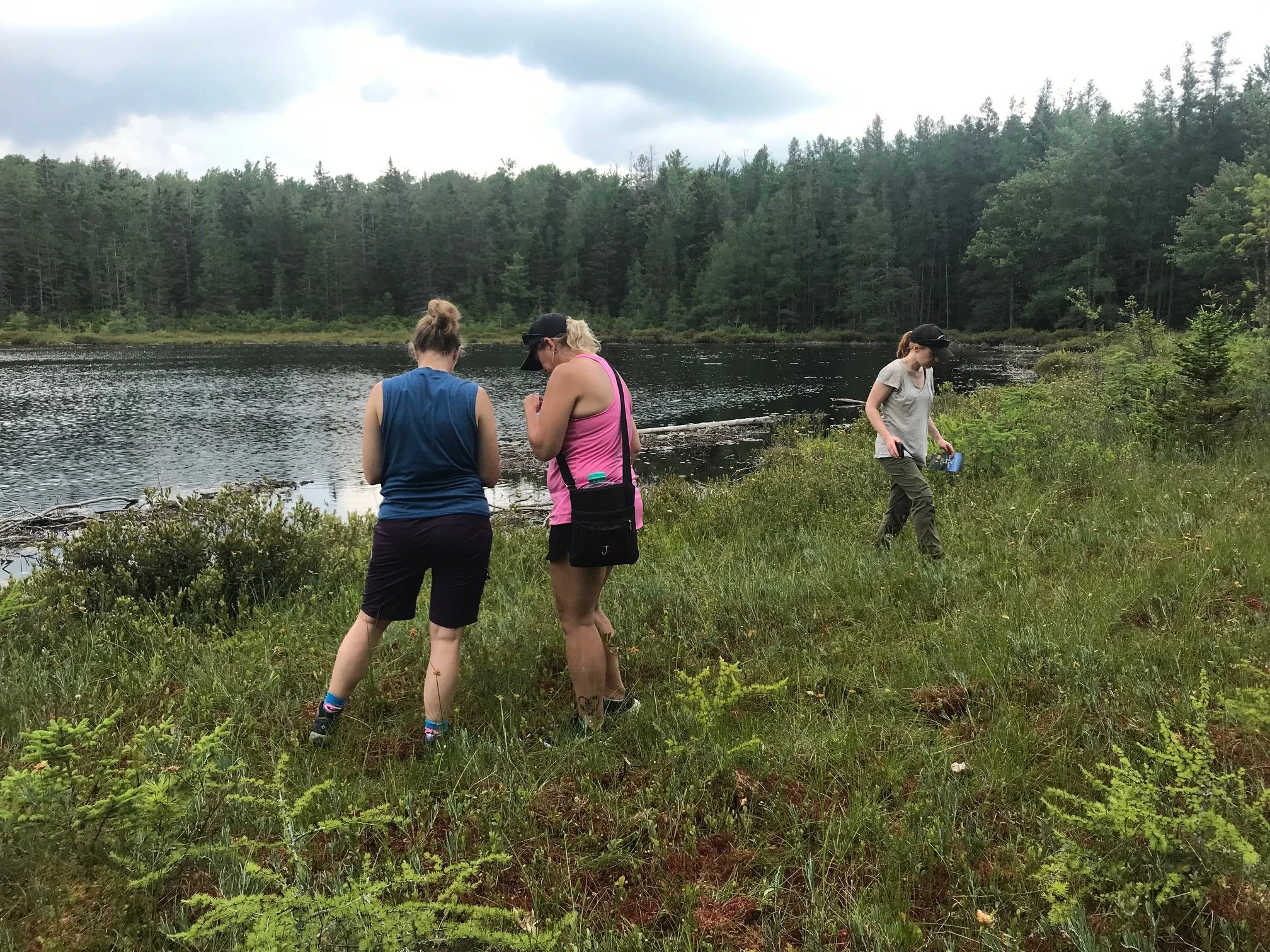
Our Work
In 1968, a small group of individuals with foresight regarding environmental matters in Otsego County banded together to form the Otsego County Conservation Association. OCCA remains the only regional environmental organization working on a broad spectrum of programs to protect our local natural resources and educate the general public about critical environmental issues and concerns.
Over the past 55 years, OCCA has been involved in virtually every major environmental issue facing Otsego County and has accumulated many accomplishments in environmental restoration, protection, and education.
Conservation
-
OCCA works hard to manage invasive species and educate county residents about their spread. We partner with the Catskill Regional Invasive Species Partnership for monitoring projects throughout the season. OCCA relies on volunteers and seasonal interns to complete this vital work. Check out our calendar to find our next project.
-
Citizen Science is the first countywide stream monitoring program carried out by volunteers with OCCA’s coordination in the New York portion of the Chesapeake Bay watershed. It is an effective way to collect data that can help inform environmental policy, provide baseline conditions, and track long-term changes across the landscape.
Volunteer recruitment is always ongoing. To become a citizen monitor, check out our page or call Shelby MacLeish at 607-547-4488.
-
In May, OCCA, Otsego Land Trust, and Otsego 2000 convened a group of over 40 stakeholders from all over the county to discuss and create actions around the Harmful Agal Bloom (HABs) issue. The group, comprised of representatives from municipal, educational institutions, state agencies, lake associations, environmental organizations, and local committees, wanted to create a central repository for information on HABs. With the help of our Watershed Facilitator and the Otsego County Department of Health, the Otsego HABs website was created. THIS SITE has information about what HABs are, what to look out for when assessing if you should go in a body of water, and resource links to all of the local science happening here to understand HABs and help toward long-term management solutions.
Recycling
-
A large recycling festival where OCCA invites Otsego County residents to bring their hard-to-recycle items to Brewery Ommegang, where we collect them. The OCCA recycling committee decides on items to be recycled, but the list usually includes textiles, Styrofoam, shredding, and e-waste.
-
OCCA partners with Otsego County to sponsor the plastic bag challenge were local schools race to collects the most plastic, by weight. Learn More
-
OCCA partners with Otsego County Department of Solid Waste for the annual August event. Learn More
Current Projects:
Local Invasive Species
-
Description
European water chestnut is a distinct floating plant that can be recognized by its triangular leaves with saw-tooth-like margins. Water chestnut grows from a central point in a rosette and has long, trailing roots resembling milfoil species. The adventitious roots are loosely rooted in the substrate, but water chestnut can survive free of the substrate for long periods. Typically, water chestnut is associated with its distinct emergent leaves but also produces small, linear submerged leaves above the root system. Each emergent leaf has an inflated sac along the stem that provides flotation.
Best Management Practices
The best way to deal with water chestnut is by hand pulling all visible plants, making sure to include the roots as well. This is best done before June when the plants begin flowering and producing nutlets. For large infestations, mechanical harvest is best. Nutlets can persist in the substrate for up to 5 years and can be transported by waterfowl and geese, so continued monitoring and periodic removals are necessary.
-
Description
Yellow floating heart can be identified by its round, heart-shaped leaves that float like “lily pads”, and its 5-petaled, yellow flowers. The flowers, which are visible from June to September, are fringed, making them distinct from the commonly confused Spatterdock, which forms a cup-shaped flower. Plantlets form at nodes interspaced along long, branching stolons (~6’ long). The leaves are typically light green and have wavy margins. The underside of the leaves can sometimes be light purple to reddish. Yellow floating heart produces tuberous rhizomes from the floating plantlets, but the main stolon is rooted in the substrate. The flower produces a capsule-like fruit that contains seeds with hairs that allow it to attach to waterfowl and other aquatic animals. Infestations can also spread from plantlets that wash downstream.
Best Management Practices
Mechanical removal is the most effective method for tackling this species, but glyphosate is a likely candidate for impactful chemical removals. If an herbicide were to be used, an application must be carried out with great caution so as to avoid native species, and ensure the chemical being used is aquatic safe.
-
Description
The hemlock woolly adelgid (HWA) is a small, aphid-like insect that attacks and feeds on North American hemlock trees. HWA can be hard to spot as they are very small (<1.5 mm) and look like tiny black specks most of the year. However, female HWA create white, woolly masses (ovisacs) on the undersides of hemlock branches at the base of the needles to overwinter. Infested hemlock trees will have gray-tinted needles and have noticeable needle loss and branch dieback. It can take 4-10 years for a tree to die off after being infested with HWA.
All species of hemlock are vulnerable to HWA, however, the most damage and death typically occurs in eastern hemlocks (Tsuga canadensis) and Carolina hemlocks (Tsuga caroliniana).
Best Management Practices
To help stop the spread of HWA, be sure to clean any equipment or gear that was used near an infestation site, even if you did not directly contact any trees. Leave brush and other infested materials where found, do not transport branches or firewood from infested sites.
If you have trees on your property that have been confirmed to be infested with HWA, contact OCCA for tips on how to manage HWA.
-
Description
European frogbit is commonly found in wetlands, marshes, and slow-moving water bodies. Typically, the leaf of frogbit is heart-shaped, about 1-2 inches wide, with a green topside and purple-red underside. It is a free-floating plant, meaning it is not rooted to the bottom and can move with the wind. A distinguishing characteristic of this invasive is the single white flower. Each individual will produce one white flower, so multiple flowers indicate multiple plants. Large mats can take over habitats, blocking sunlight to native plants and clogging waterways.
Best Management Practices
If caught early frogbit is easy to remove by hand pulling. The plants are not usually rooted but can be tangled with submerged aquatic vegetation. Carefully untangling the plant and removing it are recommended as new plants can form from fragments. Harvested plants should be left to dry out away from water sources or disposed of in trash bags. Using it as compost is also a terrific way to dispose of frogbit! After harvesting, continue monitoring the waterbody for new or overlooked plants.
For more heavily infested water bodies it is suggested to harvest near launches to help prevent its spread. Herbicidal options are available, but the treatment of severe infestations is usually ineffective and expensive.
-
Description
The effects of Emerald Ash Borers (EAB) are more commonly observed than the insects themselves, however, larvae, pupae, and adults can be found upon closer inspection. Ash trees infested with EAB often begin to drop large branches without notice that shatter when they hit the ground. Their bark begins to fleck and crack and when peeled away tunnels bored into the wood are apparent. When emerging EAB leave small, D-shaped holes in the wood. Leaves will begin to die back and discolor as EAB kill their host tree.
The larvae are larger than the adults, between 25-32mm in length when fully grown. They tend to be cream-colored with broad, flattened brown heads. Larvae have a 10-segmented abdomen and a fork-like appendage on the tip of the abdomen.
Pupae are between 10-15mm long and a creamy white color. As they mature they begin taking on the emerald colors of the adults. Once mature, they bore out of the wood leaving small D-shaped exit holes.
Adult EAB are bright, metallic green insects with elongated, flattened bodies. The underside of the elytra is typically bright red. Adults are between 8-14mm long and ~3mm wide. Adults feed on the leaves of their host trees through much of their lives and deposit their eggs between bark crevices or cracks in late June to early July.
Best Management Practices
EAB has become widely established in North America and eradication is unlikely at this point. Avoid moving wood out of infected areas and practice “Buy it Where you Burn it.” Infested trees can be cut down and burnt with caution, infested trees are fragile and can drop large branches without warning. Some studies using parasitic wasps are showing promise as biological control, but more research is needed.
-
Description
Spotted lanternfly (SLF) nymphs are black with white spots, and later turn red before transitioning into adults later in the year. Nymphs are small, under 1” in length, and may be difficult to spot. The early nymphs can be found as early as April until July, while the later-stage red nymphs can be found from July until September.
Adults begin to emerge in July and are approximately 1” in length and ½” wide when resting. The forewings (seen while resting) are light grey, with simple black spots ending with a band of much smaller dots on the wing's outer portion. The inner portions of the hindwings are bright red with black spots, and the outer edges are black with a white stripe. The body of the spotted lanternfly is dark with a yellowish underside.
The egg masses laid by adults are a smooth and greyish brown, often covered with a smooth, waxy coating. They are easily mistaken for dried patches of mud.
Best Management Practices
Scrape egg masses from surfaces and destroy them by crushing, burning, or submerging them in alcohol. Inspect trailers, vehicles, and other moving outdoor structures for egg masses on exposed, smooth surfaces before transporting them to new areas. Photograph, report, and kill any adult insects and nymphs found.
If you have identified an invasive species on your property, contact Jeff O’Handley at 607-282-4087 for help with removal.
Education
-
OCCA regularly organizes nature walks on local trails. We regularly have “Get the Kids Out” programs for families and The homeschool nature group on our calendar. Beyond that, OCCA program staff work with volunteers and partner organizations to offer programs year-round to Otsego County residents.
-
Learn about many topics in ecology, natural resources, land management, and much more. The Be Informed Lecture series has a subject for everyone. This bi-monthly series is a great way to stay current on various topics.
-
Funded by the National Oceanic and Atmospheric Administration (NOAA), this program is a three-year professional development initiative that will increase the development and implementation of Meaningful Watershed Educational Experiences (MWEEs) throughout the New York portion of the Chesapeake Bay watershed. MWEEs are learner-centered experiences in which students investigate local environmental issues and complete informed action projects. MWEEs advance ecological literacy and stewardship while increasing standards-based student achievement.
Outreach
-
Earth Festival is a fun, family-friendly, interactive event featuring exhibitors, vendors, activities and workshops with an environmental theme. OCCA partners with local, environmental organizations to put on the best festival for the surrounding community.
-
OCCA has partners all over Otsego County (see partners page). Come find us at local event to learn more about our programs.
-
Sign up for the OCCA eco-bulletin today. Our twice monthly newsletter will give you ecological news, updates and an event list.




